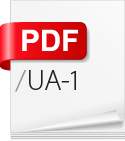About the Author
Accessibility isn’t just for websites anymore!
Here’s how the Sec. 508 Refresh affects your work and how you can prepare for it.
A huge oversight was built into the original Section 508 accessibility standards released in 2000, 18 years ago. The requirements addressed government information only on websites and failed to specify that other government information needed to be accessible, too.
For years, the industry debated whether PDFs, Word, and PowerPoint documents on a website were also required to be accessible. It was a gray area. Fortunately, most government agencies set policies to make those document files accessible, too, along with their agency websites.
The Sec. 508 Refresh (which became effective January 20, 2018) introduces the term ICT (Information Communication Technology) to our US federal accessibility regulation. As defined, the term "ICT" broadly includes any file format or technology used to communicate information — digital files, media, social media, telecommunications, software, hardware, other devices, and support documentation/services.
The intent of this broad definition is to have the term apply to future technologies as they become available without needing to revamp the regulations.
This blog-a-torial examines how the Sec. 508 Refresh affects documents, such as MS Word, PowerPoint, and PDFs.
 View the final Sec. 508 Rule at https://www.access-board.gov/guidelines-and-standards/communications-and-it/about-the-ict-refresh/final-rule
View the final Sec. 508 Rule at https://www.access-board.gov/guidelines-and-standards/communications-and-it/about-the-ict-refresh/final-rule
If you work for a US federal government agency as either an employee, contractor, or freelancer, your knowledge of Sec. 508 and accessibility requirements will be crucial to your job. Many agencies have extended Sec. 508 to also cover work performed by recipients of their grants.
Sec. 508 is part of the US civil rights group of laws that require equal access and opportunity for individuals with disabilities, including members of the public as well as federal employees themselves.
E201.1 Scope. ICT that is procured, developed, maintained, or used by agencies shall conform to the Revised 508 Standards.
E205.2 Public Facing. Electronic content that is public facing shall conform to the accessibility requirements specified in E205.4.
E205.3 Agency Official Communication. Electronic content that is not public facing shall conform to the accessibility requirements specified in E205.4 when such content constitutes official business and is communicated by an agency through one or more of the following… [The regulation defines 9 categories of non-public facing ICT, mainly an agency's communication to its employees.]
Essentially, anyone who creates a document for the US federal government — writers, editors, subject matter experts, analysts, desktop publishers, visual information specialists, and web developers — will need to understand Section 508's requirements and create compliant documents.
Nearly every federal document is covered by the new expanded standards.
Do you work for state and local government agencies, nonprofits, or educational institutions? It's expected that most state and local government agencies will eventually adopt the federal standards, and most nonprofit organizations will follow suit, also.
Is your state on board?
Check this webpage from 3PlayMedia to see if your state has adopted the federal Sec. 508 guidelines.
www.3playmedia.com/2018/09/24/do-your-states-laws-require-section-508-compliance
Educational institutions are covered under several laws and regulations, including: the Individuals with Disabilities Education Act (IDEA); Sec. 504 of the Rehabilitation Act of 1973 (a federal law that requires a school district to provide a free and appropriate public education to each child with a disability in the district); and Title II of the Americans with Disabilities Act (ADA). All levels of education are covered by these laws, from K–12 through college and post-graduate curricula.
International accessibility standards for websites have been adopted by many governments worldwide since their release in 2008. These standards are known as WCAG 2.0 (Web Content Accessibility Guidelines) and are available at www.w3.org/TR/WCAG20. (The acronym WCAG 2.0 is often pronounced “W-kahg-two.”)
 Rather than writing our own US accessibility standards, the Sec. 508 Refresh incorporates by reference the WCAG 2.0 international accessibility standards. (See 702.10 Worldwide Web Consortium (W3C) of Sec. 508 for details.)
Rather than writing our own US accessibility standards, the Sec. 508 Refresh incorporates by reference the WCAG 2.0 international accessibility standards. (See 702.10 Worldwide Web Consortium (W3C) of Sec. 508 for details.)
 But WCAG 2.0 addresses only web content, and not documents and other common types of files. It's difficult to apply WCAG to documents.
But WCAG 2.0 addresses only web content, and not documents and other common types of files. It's difficult to apply WCAG to documents.
The Sec. 508 Refresh also incorporates additional accessibility standards, including the PDF/UA-1 (universal access) standard for PDF documents. (See 504.2.2 PDF Export and 702.3.1 ANSI/AIIM/ISO 14289-1-2016 of Sec. 508 for details.)
 ISO standards for accessibility:
ISO standards for accessibility:
WCAG 2.0 = ISO
40500:2012
PDF/UA-1 = ISO 14289-1-2016
Accessibility begins with Word.
Or with PowerPoint, Excel, and other common office programs.
Because most of our content begins with a writer using Word or another word processor, accessibility should be built into the content right from the start, with the very first word that’s written by the author.
Making a Word document accessible is not difficult to do, but it does require a refresher class in using Word and PowerPoint's tools. Premade accessible templates speed up the process.
Accessibility isn’t added or tacked onto a document once it’s handed to the IT staff, webmasters, or desktop publishers. By then it’s too late in the production process to efficiently make the document accessible. It’s time-consuming and difficult to make a fully accessible document from a poorly constructed Word or PDF file. Some documents simply can’t be fully remediated once they’re in PDF format.
Instead, adjust your office’s workflow just a bit to bring accessibility requirements onto everyone’s everyday to-do list. Most recent software programs have tools and features to help you do this efficiently and fairly painlessly. It’s just a matter of learning how to use these new tools.

 Learn how to export accessible PDFs from Word.
Learn how to export accessible PDFs from Word.
We're technologists for accessible design and publishing. We help agencies, academics, authors, designers, and publishers build accessibility into their documents from start to finish.
We've been in the publishing industry for eons and our first classes in accessible documents were held in 2001, soon after Sec. 508 went into effect and WCAG 1 was released.
Summary: we know publishing, from editorial to design to distribution. And we focus on helping you maximize your technology, streamline your workflow, and seamlessly build accessibility into your publishing workflow.
Sign up for our upcoming classes or we can bring a custom curriculum to your agency that can train your writers, editors, desktop publishers, and webmasters.
We’re committed to making documents accessible for the nearly 35% of our fellow citizens who have disabilities that make it difficult for them to use computer technologies. .
 We teach how to make your documents accessible.
We teach how to make your documents accessible.
Let us know how we can help you fish!
— Bevi Chagnon
CEO and Founder, PubCom
Note: This blog post was originally published in March 2011 and was updated as the Sec. 508 Refresh migrated from draft through multiple review cycles to the final published Rule in the US Federal Register in January 2017. This is the most recent version of this post.